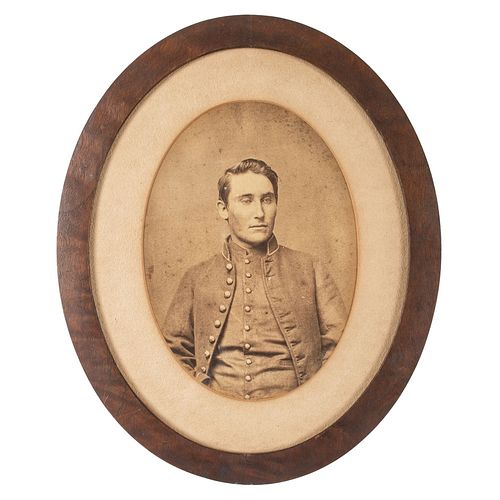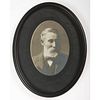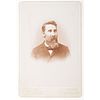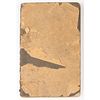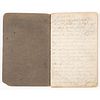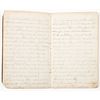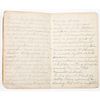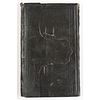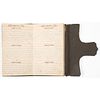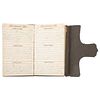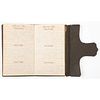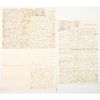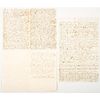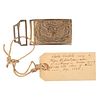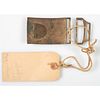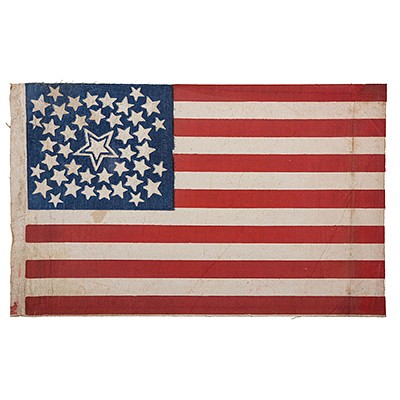Civil War Archive of Thomas P. Dickson, Ohio 7th Volunteer Infantry, Incl. Diary, Journal, & Letters
About Seller
6270 Este Ave.
Cincinnati , OH 45232
United States
With offices in Cincinnati, Cleveland and Denver, Cowan’s holds over 40 auctions each year, with annual sales exceeding $16M. We reach buyers around the globe, and take pride in our reputation for integrity, customer service and great results. A full-service house, Cowan’s Auctions specializes in Am...Read more
Two ways to bid:
- Leave a max absentee bid and the platform will bid on your behalf up to your maximum bid during the live auction.
- Bid live during the auction and your bids will be submitted real-time to the auctioneer.
Bid Increments
| Price | Bid Increment |
|---|---|
| $0 | $25 |
| $500 | $50 |
| $1,000 | $100 |
| $2,000 | $250 |
| $5,000 | $500 |
| $10,000 | $1,000 |
| $20,000 | $2,500 |
| $50,000 | $5,000 |
| $100,000 | $10,000 |
About Auction
Nov 19, 2020
Cowan’s Auctions, a Hindman Company, is pleased to present the November 19 Fall Auction, featuring over 400 lots of historically significant photography, manuscript material, artwork, and other ephemera dating from the 18th through the early 20th century, including the Civil War. Cowan's Auctions dawnie@cowans.com
- Lot Description
Lot comprised of 2 Civil War diaries, 17 war-date letters (with 5 original covers, stamps removed), 3 photographs, including an early Civil War-era portrait of Dickson, a cabinet card and silver gelatin photograph of him in his later years, copy of Company C, and a belt buckle that was "worn by Thos. P. Dickson when Lieutenant in Union army 1864 till close of civil war, Apr. 1865," according to handwritten tag accompanying the buckle, ca 1861-1863.
In April 1861, Oberlin College student Thomas P. Dickson was following the rapidly changing course of national events closely, concerned about the direction the nation was taking. "One day Sumpter is taken," he wrote, "the next it is reinforced. Yesterday Virginia had refused to go out of the union, today has seceded and Harpers Ferry is in the hands of the revels, and they are marching toward Washington. Troops are gathering in every town and starting for the conflict...A meeting was called Wednesday night to discuss the issues of the day and about 2,000 were present." In short order, Dickson enlisted, beginning his letter to inform his mother in classic style: "Before you read these, I shall be away at the camp or perhaps in the land of traitors, surrounded by the smoke of battle..." On April 26, 1861, he added that his company, which became part of the three month 7th Ohio Infantry, had already been mobilized. "Mother, your last words to me were 'do your duty, you know it well enough,' and is it not my duty to prepare to defend my country and the cause of humanity. I join this company because it is mostly composed of moral christian young men who go because they feel it is not their duty."
In August 1861, now reenlisted in the three years 7th Ohio, Dickson wrote a long letter on the disastrous Battle of Cross Lanes, at which the 7th Ohio was surprised and routed by Confederate forces. Without denying the results, he disputed much of the press coverage of the debacle. "I think there can be no reflections at all on the conduct of [Col.] Tyler or any of his aids for they did the best they could. He was ordered back to Crosslanes and when he asked assistance, cox told him he had magnified two companies to two regiments and that he expected him to go at all hazards. Under the circumstances I think Tyler was justified in advancing even on the Sabbath, and it would not likely have made any difference in the disaster as the enemy were entrenched and would continued in the same place till Monday morn or Tues… Our force was so small that we could not send pickets out as far as might have been..." In a second, longer letter, Dickson ruefully described leaving their wounded behind to the mercy of the enemy, the value of sidearms, and other matters.
The heart of the Dickson Papers, however, relates to the Shenandoah Valley Campaign of 1862, at which Stonewall Jackson's legend was built at the expense of regiments like the 7th. His description of a march early in the campaign provides a taste for what it was like for men in the ranks. The 7th Ohio was bringing up the rear, and Dickson wrote "...just as we were starting a single report and in a little a volley of musketry told that the enemy's pickets had been attacked. We moved on slowly about 4 miles when we were enlivened by the firing of artillery and by the heavy hollow from which followed the sharp report of our Parrott guns we know that our advance was disputed by artillery but the firing soon ceased and the column moved on, but a dense smoke ahead indicated that the rebels were at their old work and most likely another was added to the list of bridges burnt by the secesh..."
The diaries cover the period of the Shenandoah Campaign, March-May 1862 and May 1862-January 15, 1863. Dickson's description of the First Battle of Winchester was memorable: "Last Saturday we heard considerable commotion near Winchester and our brigade was ordered our and lay all night in a field in town but the enemy did not advance…[The next day] We moved a little to one side to get out of their range and waited a little when we received orders to take the rebel battery. Our brigade started a way around to the right, the 7th taking the lead, marching in close column through the woods to prevent being seen. We had passed one of the guns and were about even with the rest when a line of sharp shooters opened on us. The bullets came quite thick and with rather deadly effect, many of our brave boys falling before them. They got behind a large stone fence and kept up a continual fire upon us. We had very little chance to shoot them but whenever they showed their heads we popped it to them as far as we could and the dead and wounded testified that we did not shoot for nothing... They fought desperately but we kept advancing and they had to retreat..." The second diary includes outstanding descriptions of the hostility of the women in the Valley, spitting on Union soldiers as they passed, and the Battle of Port Republic and Cedar Mountain, in which Dickson was wounded in the shoulder and thigh. In addition to the diary entries, there are six letters written while Dickson was in hospital, describing the conditions as well as his conditions.
One additional letter stands out. In July 1862, Dickson witnessed a rare site of a woman in camp: "Among the most noted persons on the field was Mrs. Maj. Bell Reynolds. She was mounted on a lively little horse and dashed around quite gallantly. Her dress is something of the bloomers style and a piece off she looks very much like a small man. She rides a side saddle however, which some of the boys think is rather inconsistent. Another female with the rank of Capt. was also there but did not attract much attention and soon left in disgust. One wears the gold leaves on her shoulders and the other the two bars to mark her rank just as a major or captain..." Belle Reynolds followed her husband, a lieutenant in the 17th Illinois, throughout his service. She and her friend Mrs. N were noted for their heroism helping the wounded at the Battle of Shiloh.
Also included is a very good copy of an early and scarce regimental history, Theodore Wilder, The History of Company C, Seventh Regiment O.V.I. (Oberlin: J.B.T. Marsh, 1866), and a printed Roster of the Survivors of Company C, 7th Regiment, Ohio Volunteer Infantry (April 1911). A previous owner has transcribed the letters and interwoven them with sections from this history to present a narrative covering Dickson's time in the 7th Ohio Volunteers.
A college educated man, pious and thoughtful, Dickson writes long and interesting letters that provide insight into the first two years of the war from the perspective of an active, but far from successful union regiment. - Shipping Info
-
Buyers are required to pay for all packing, shipping and insurance charges. Overseas duty charges are the responsibility of the successful Bidder. Be aware that for larger and/or valuable items, shipping charges can be substantial. - If there is no shipping amount on listed your invoice, you will need to make arrangements to pick up or ship your purchase through an alternative shipping company. Our shipping department can be contacted at 513.871.1670 (ext. 219) or email shipping@cowans.com. - Shipping charges include insurance for your order while in transit. If you have private insurance we will adjust your charge to include only packing and shipping. - Please allow 14 – 21 days after payment to package and ship your purchase as carefully as possible.
-
- Buyer's Premium



 EUR
EUR CAD
CAD AUD
AUD GBP
GBP MXN
MXN HKD
HKD CNY
CNY MYR
MYR SEK
SEK SGD
SGD CHF
CHF THB
THB